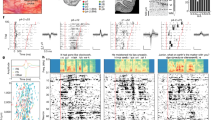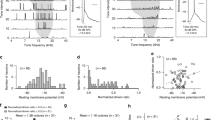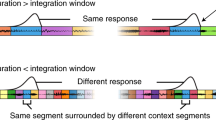Abstract
The auditory neural code must serve a wide range of auditory tasks that require great sensitivity in time and frequency and be effective over the diverse array of sounds present in natural acoustic environments. It has been suggested1,2,3,4,5 that sensory systems might have evolved highly efficient coding strategies to maximize the information conveyed to the brain while minimizing the required energy and neural resources. Here we show that, for natural sounds, the complete acoustic waveform can be represented efficiently with a nonlinear model based on a population spike code. In this model, idealized spikes encode the precise temporal positions and magnitudes of underlying acoustic features. We find that when the features are optimized for coding either natural sounds or speech, they show striking similarities to time-domain cochlear filter estimates, have a frequency-bandwidth dependence similar to that of auditory nerve fibres, and yield significantly greater coding efficiency than conventional signal representations. These results indicate that the auditory code might approach an information theoretic optimum and that the acoustic structure of speech might be adapted to the coding capacity of the mammalian auditory system.
This is a preview of subscription content, access via your institution
Access options
Subscribe to this journal
Receive 51 print issues and online access
$199.00 per year
only $3.90 per issue
Buy this article
- Purchase on Springer Link
- Instant access to full article PDF
Prices may be subject to local taxes which are calculated during checkout




Similar content being viewed by others
References
Barlow, H. B. in Sensory Communication (ed. Rosenbluth, W. A.) 217–234 (MIT Press, Cambridge, Massachusetts, 1961)
Atick, J. J. Could information-theory provide an ecological theory of sensory processing. Network 3, 213–251 (1992)
Simoncelli, E. & Olshausen, B. Natural image statistics and neural representation. Annu. Rev. Neurosci. 24, 1193–1216 (2001)
Laughlin, S. B. & Sejnowski, T. J. Communication in neuronal networks. Science 301, 1870–1874 (2003)
Lewicki, M. S. Efficient coding of natural sounds. Nature Neurosci. 5, 356–363 (2002)
Shamma, S., Chadwick, R., Wilbur, W. J., Morrish, K. A. & Rinzel, J. A biophysical model of cochlear processing: Intensity dependence of pure tone responses. J. Acoust. Soc. Am. 78, 1612–1621 (1986)
Yang, X., Wang, K. & Shamma, S. Auditory representations of acoustic signals. IEEE Trans. Inf. Theory 38, 824–839 (1992)
Lewicki, M. S. & Sejnowski, T. J. in Advances in Neural Information Processing Systems (eds Kearns, M. J., Solla, S. A. & Cohn, D. A.) vol. 11, 730–736 (MIT Press, Cambridge, Massachusetts, 1999)
Lewicki, M. S. in Probabilistic Models of the Brain: Perception and Neural Function (eds Rao, R. P. N., Olshausen, B. A. & Lewicki, M. S.) 241–255 (MIT Press, Cambridge, Massachusetts, 2002)
Smith, E. C. & Lewicki, M. S. Efficient coding of time-relative structure using spikes. Neural Comput. 17, 19–45 (2005)
Davis, G., Mallat, S. & Avellaneda, M. Adaptive greedy approximations. Construct. Approx. 13, 57–98 (1997)
Mallat, S. G. & Zhang, Z. Matching pursuits with time–frequency dictionaries. IEEE Trans. Signal Process. 41, 3397–3415 (1993)
de Ruyter van Steveninck, R. & Bialek, W. Realtime performance of a movement sensitive neuron in the blowfly visual system: Coding and information transfer in short spike sequences. Proc. R. Soc. Lond. B 234, 379–414 (1988)
Olshausen, B. A. in Probabilistic Models of the Brain: Perception and Neural Function (eds Rao, R. P. N., Olshausen, B. A. & Lewicki, M. S.) 257–272 (MIT Press, Cambridge, Massachusetts, 2002)
Emmons, L. H., Whitney, B. M. & Ross, D. L. Sounds of the Neotropical Rainforest Mammals [audio CD] (Library of Natural Sounds, Cornell Laboratory of Ornithology, Ithaca, New York, 1997).
deBoer, E. & deJongh, H. On cochlear encoding: Potentialities and limitations of the reverse correlation technique. J. Acoust. Soc. Am. 63, 115–135 (1978)
Carney, L. H. Sensitivities of cells in the anteroventral cochlear nucleus of cat to spatiotemporal discharge patterns across primary afferents. J. Neurophysiol. 64, 437–456 (1990)
Recio-Spinoso, A., Temchin, A. N., van Dijk, P., Fan, Y.-H. & Ruggero, M. A. Wiener-kernel analysis of responses to noise of chinchilla auditory-nerve fibers. J. Neurophysiol. 93, 3635–3648 (2005)
Irino, T. & Patterson, R. A level-dependent auditory filter: the gammachirp. J. Acoust. Soc. Am. 101, 764–774 (1997)
Carney, L. H., McDuffy, M. J. & Shekhter, I. Frequency glides in the impulse responses of auditory-nerve fibers. J. Acoust. Soc. Am. 105, 2384–2391 (1999)
Acknowledgements
E.C.S. was supported by a National Institutes of Health training grant. This material is based on work supported by a National Science Foundation grant to M.S.L. Empirical data in this paper were acquired from Boston University's Earlab, an online, freely accessible auditory database (http://earlab.bu.edu). Author Contributions M.S.L. and E.C.S. developed the model, analysed the results and wrote the paper together; E.C.S. designed and ran the simulations.
Author information
Authors and Affiliations
Corresponding author
Ethics declarations
Competing interests
Reprints and permissions information is available at npg.nature.com/reprintsandpermissions. The authors declare no competing financial interests.
Supplementary information
Supplementary Discussion
This file contains additional discussion on the non-linear nature of the spike coding algorithm and comparison of learned kernels and auditory revcor filters.
Supplementary Methods
This file contains additional details of the methods used in this study.
Supplementary Figure 1
Alternate efficient codes emerge when training on other sound ensembles.
Supplementary Figure 2
A quantitative comparison of the correlation between cat revcor filters and different codes.
Supplementary Figure 3
Characterization of spike code kernel functions by reverse correlation.
Rights and permissions
About this article
Cite this article
Smith, E., Lewicki, M. Efficient auditory coding. Nature 439, 978–982 (2006). https://doi.org/10.1038/nature04485
Received:
Accepted:
Issue Date:
DOI: https://doi.org/10.1038/nature04485
This article is cited by
-
Hearing as adaptive cascaded envelope interpolation
Communications Biology (2023)
-
Abstract representations emerge naturally in neural networks trained to perform multiple tasks
Nature Communications (2023)
-
Sensory perception relies on fitness-maximizing codes
Nature Human Behaviour (2023)
-
Decoding neurobiological spike trains using recurrent neural networks: a case study with electrophysiological auditory cortex recordings
Neural Computing and Applications (2022)
-
Improved shift-invariant sparse coding for noise attenuation of magnetotelluric data
Earth, Planets and Space (2020)
Comments
By submitting a comment you agree to abide by our Terms and Community Guidelines. If you find something abusive or that does not comply with our terms or guidelines please flag it as inappropriate.



